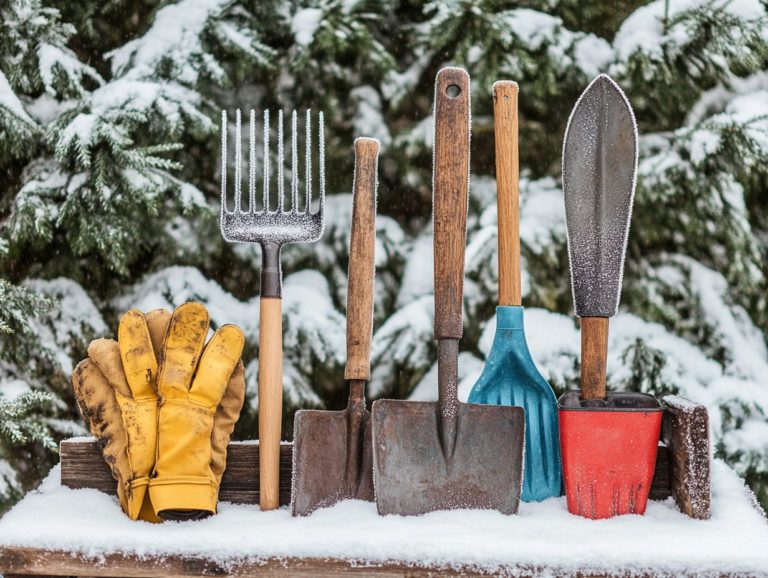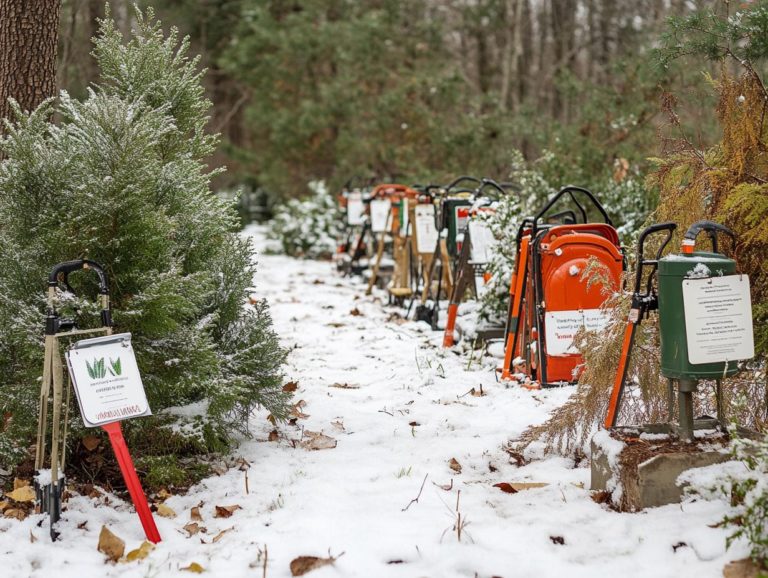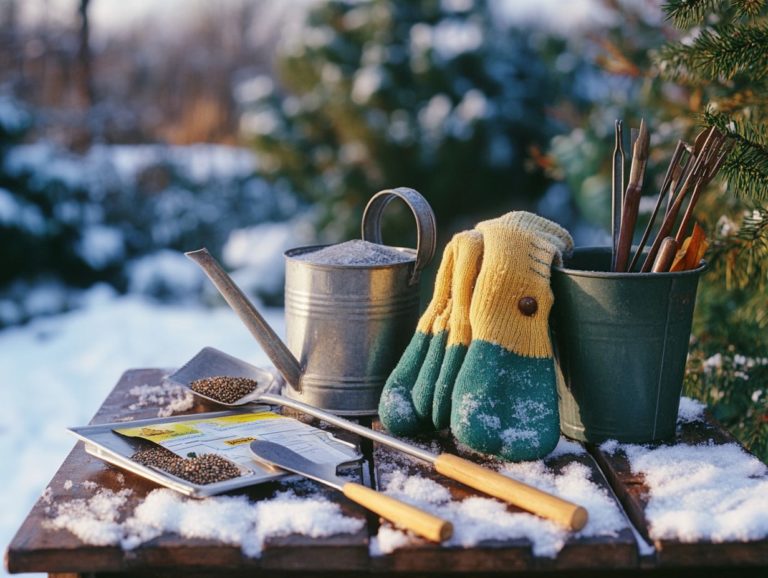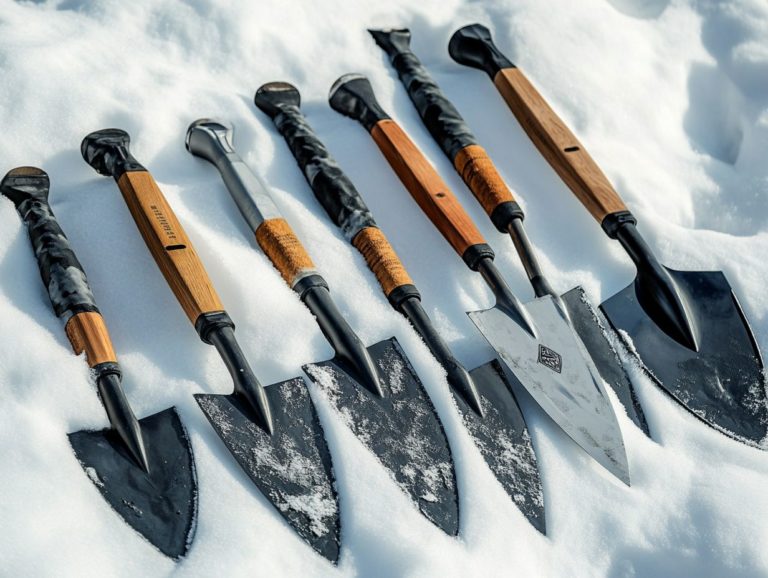Choosing the Right Rake for Winter Cleanup
When winter arrives, the allure of frosty mornings can swiftly morph into the task of cleanup. Selecting the right rake is crucial for efficiently managing leaves, debris, and snow.
This article delves into the different types of rakes tailored for winter cleanup, comparing both traditional and modern options. You’ll discover key factors to consider, along with tips for effective usage and maintenance practices that can extend your rake’s life and keep it ready for action!
Prepare to elevate your winter cleanup experience with tips that can transform your cleaning process into a rewarding task!
Contents
- Key Takeaways:
- Understanding the Importance of Choosing the Right Rake
- Types of Rakes for Winter Cleanup
- Factors to Consider When Choosing a Rake
- Tips for Using Your Rake Effectively
- Proper Maintenance of Your Rake
- Frequently Asked Questions
- What type of rake should I use for winter cleanup?
- Can I use a regular garden rake for winter cleanup?
- What is the ideal width for a winter cleanup rake?
- Should I choose a metal or plastic rake for winter cleanup?
- What type of handle should I look for in a winter cleanup rake?
- Is it necessary to have a specialized winter cleanup rake, such as a roof rake?
Key Takeaways:
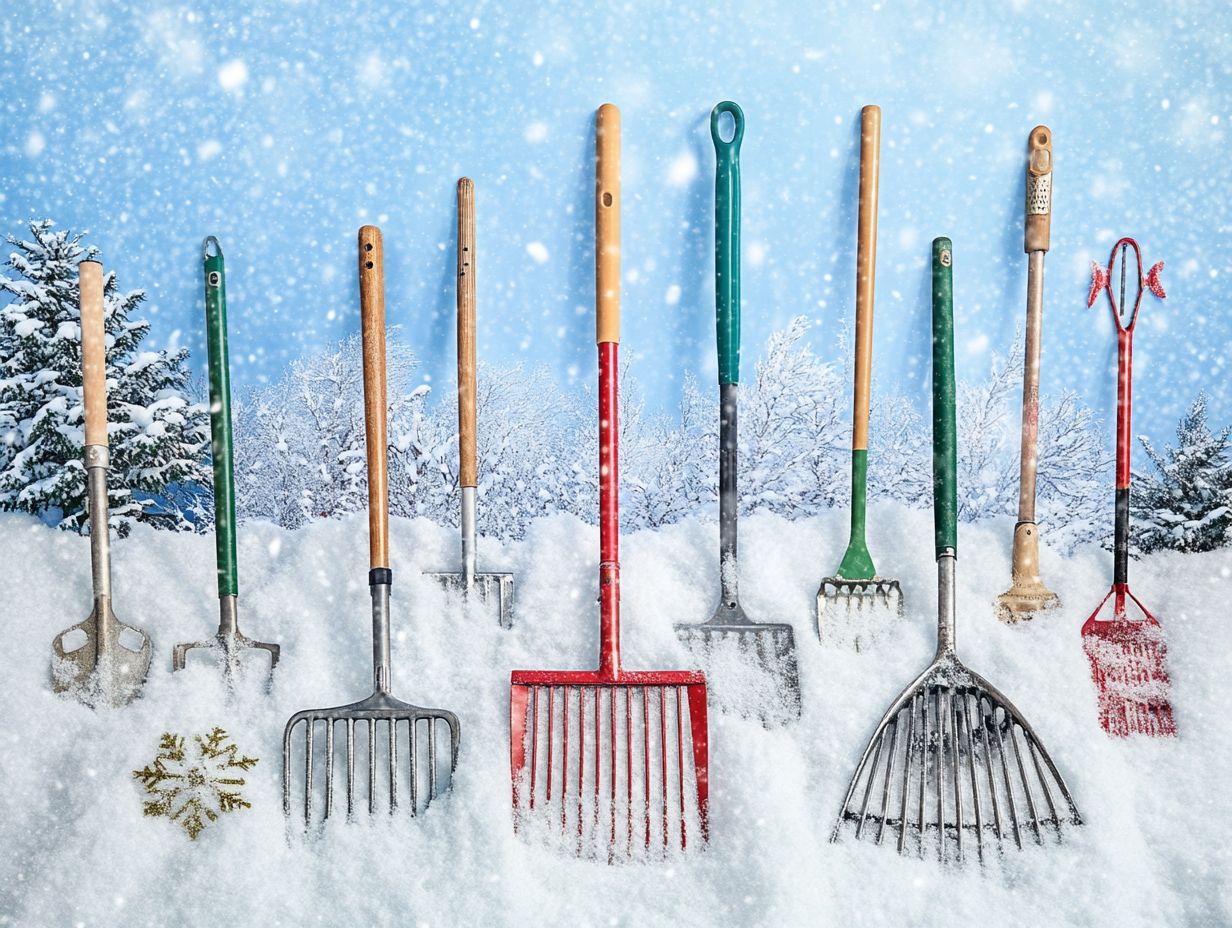
Choose the right rake for efficient winter cleanup.
Understand the differences between traditional and modern rakes to find the best tool for the job.
Consider factors like size, material, and maintenance when selecting a rake for winter cleanup.
Understanding the Importance of Choosing the Right Rake
Selecting the right rake is crucial for effective seasonal lawn maintenance. It can dramatically enhance the efficiency of your fall lawn cleanup. As you explore the various rake types at your local home supply store, it’s important to know the distinct functions of garden rakes, leaf rakes, shrub rakes, and thatch rakes. This knowledge empowers you to choose the ideal tool for your gardening needs.
A suitable rake not only elevates the aesthetic appeal of your garden, but also promotes its health. By ensuring that tasks are completed promptly, you ll save yourself time, effort, and valuable resources for future gardening projects, like preparing for a fancy dinner.
Why the Right Rake Matters for Winter Cleanup
The right rake is essential for your winter cleanup. It ensures that you can efficiently and effectively remove leaves and debris that, if left unattended, could harm your garden’s health.
Opting for a leaf rake specifically designed for this task will allow you to gather fallen leaves with minimal effort, preventing them from becoming compacted and wet, which can lead to mold or disease. Meanwhile, a garden rake is your best friend for breaking apart stubborn clumps of dead grass or soil that may have accumulated over the winter months.
By mastering proper raking techniques like tackling the job in sections and varying your angle you not only make the chore more manageable, but also protect the underlying turf from damage. Together, these tools and techniques can significantly enhance the vitality of your garden come spring.
Types of Rakes for Winter Cleanup
When tackling winter cleanup, appreciating the different types of rakes at your disposal such as garden rakes, leaf rakes, shrub rakes, and landscape rakes can greatly elevate your efficiency in managing your garden space.
Knowing which tool to use for each task, such as a leaf scoop rake for easy collection, will streamline your efforts and ensure your garden thrives even in the colder months.
Comparing Traditional and Modern Rakes
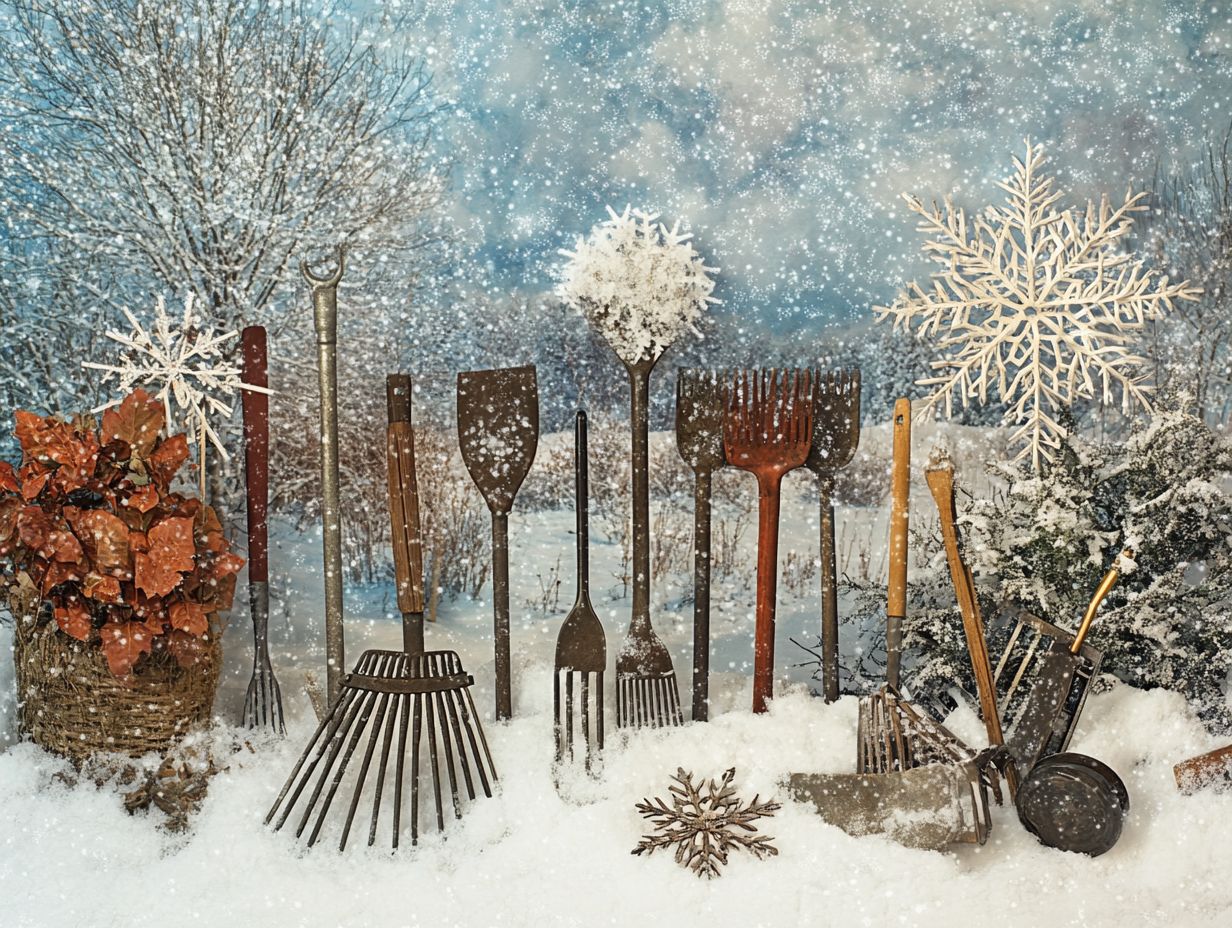
The comparison between traditional and modern rakes reveals some noteworthy differences in materials, design, and functionality. These factors significantly impact how effectively you can manage leaves and debris in your garden care routine.
Traditional rakes, often crafted from sturdy wood, exude a classic charm that many gardeners cherish. Their time-tested design offers a tactile feel and reliable performance on uneven surfaces. However, you might find them a bit heavier and less flexible, which can lead to fatigue during longer raking sessions.
On the flip side, modern rakes, constructed from lightweight materials like plastic, metal, or fiberglass, make handling and maneuverability a breeze perfect for those repetitive tasks. While wooden rakes may boast durability and aesthetic appeal, modern options often shine brighter in versatility and convenience. Ultimately, you ll need to weigh these factors carefully to choose the right tool that best fits your gardening needs.
Factors to Consider When Choosing a Rake
Selecting the perfect rake requires careful consideration of several key factors, including size, material, and unique features tailored to your gardening needs.
Whether you’re tackling thatch removal which means removing dead grass and other debris to keep your lawn healthy or managing seasonal lawn maintenance, the right rake can make all the difference in achieving optimal results.
Size, Material, and Other Features
The size and material of a rake are essential factors that significantly impact its effectiveness. Options range from compact hand rakes to specialized tools like leaf scoop rakes and artificial turf rakes, each designed for specific gardening tasks.
By understanding how these characteristics affect the overall performance of the tool, you can make informed choices that elevate your gardening game. A larger rake made of durable metal is generally better for heavy-duty jobs like clearing away substantial debris. In contrast, a lighter plastic rake might be ideal for gently tending to your flower beds.
The flexibility of the rake’s tines the prongs that help you gather debris can also enhance usability in various conditions. By thoughtfully considering your specific gardening needs, you can select the perfect rake that boosts your efficiency and transforms gardening into a more enjoyable experience.
Tips for Using Your Rake Effectively
Mastering proper raking techniques is essential for achieving a thorough fall lawn cleanup. Efficiently removing leaves and debris enhances the aesthetic appeal of your yard and promotes the health of your garden’s landscape.
Techniques for Efficient Cleanup
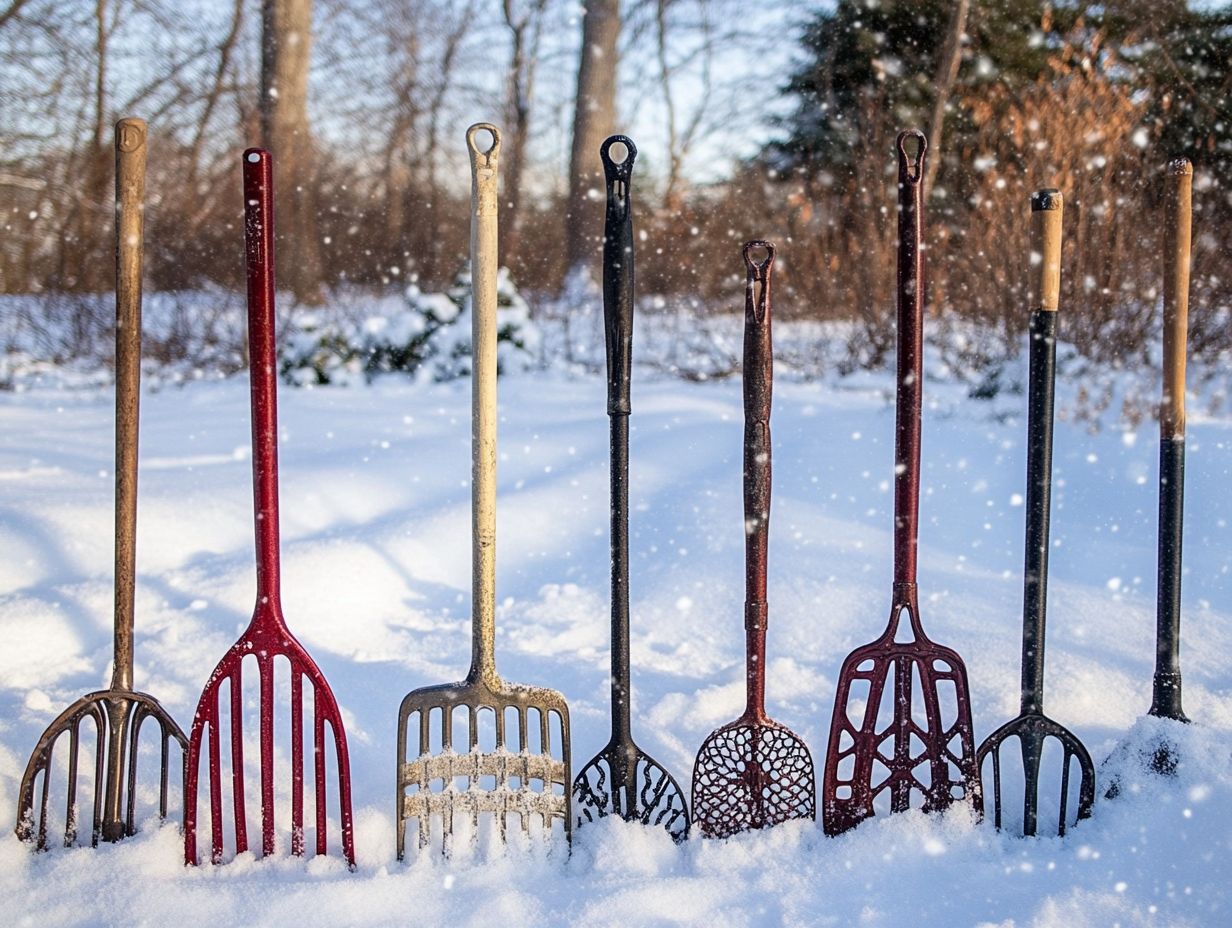
Implementing efficient cleanup techniques, especially during thatch removal, demands a strategic approach to maximize the effectiveness of your leaf rakes and other gardening tools.
To achieve optimal results, it s essential to choose the right rake for the job. For example, a fan rake is perfect for gathering leaves into neat piles, while a metal thatch rake excels at lifting and removing layers of dead grass and debris from your lawn.
Using a sturdy tarp during cleanup simplifies transporting collected materials to the compost area or the curb for collection. When you mix in a bit of elbow grease with these tools, the process becomes quicker and more thorough, setting the stage for a healthier lawn come spring.
Proper Maintenance of Your Rake
Give your rake some love to keep it in top shape! Maintaining your rake properly is crucial for extending its lifespan and ensuring it performs at its best. This is especially true for specialized tools, such as thatch rakes and garden rakes, designed for various tasks.
By giving them the care they deserve, you ll enhance their efficiency and longevity in your gardening endeavors.
How to Extend the Lifespan of Your Rake
To extend the lifespan of your rake, embrace proper maintenance techniques that align with the specific materials at play be it plastic, metal, bamboo, or other garden rake materials.
Understanding the unique characteristics of each material will guide you in selecting the most effective care strategies. For instance, if you have a metal rake, regular cleaning is a must to prevent rust from forming. Plastic rakes thrive when kept out of direct sunlight, which helps maintain their integrity and prevents brittleness. As for bamboo rakes, a gentle wipe down and an occasional oil treatment will keep them flexible and ready for action.
After each gardening session, take a moment to inspect your tools for any signs of wear, and ensure they are securely stored to prevent damage. By incorporating these straightforward yet impactful practices, you can significantly enhance the durability and functionality of your rakes, making your gardening tasks more efficient and enjoyable.
Frequently Asked Questions
Have tips or experiences of your own? Share them with us and join the conversation!
What type of rake should I use for winter cleanup?
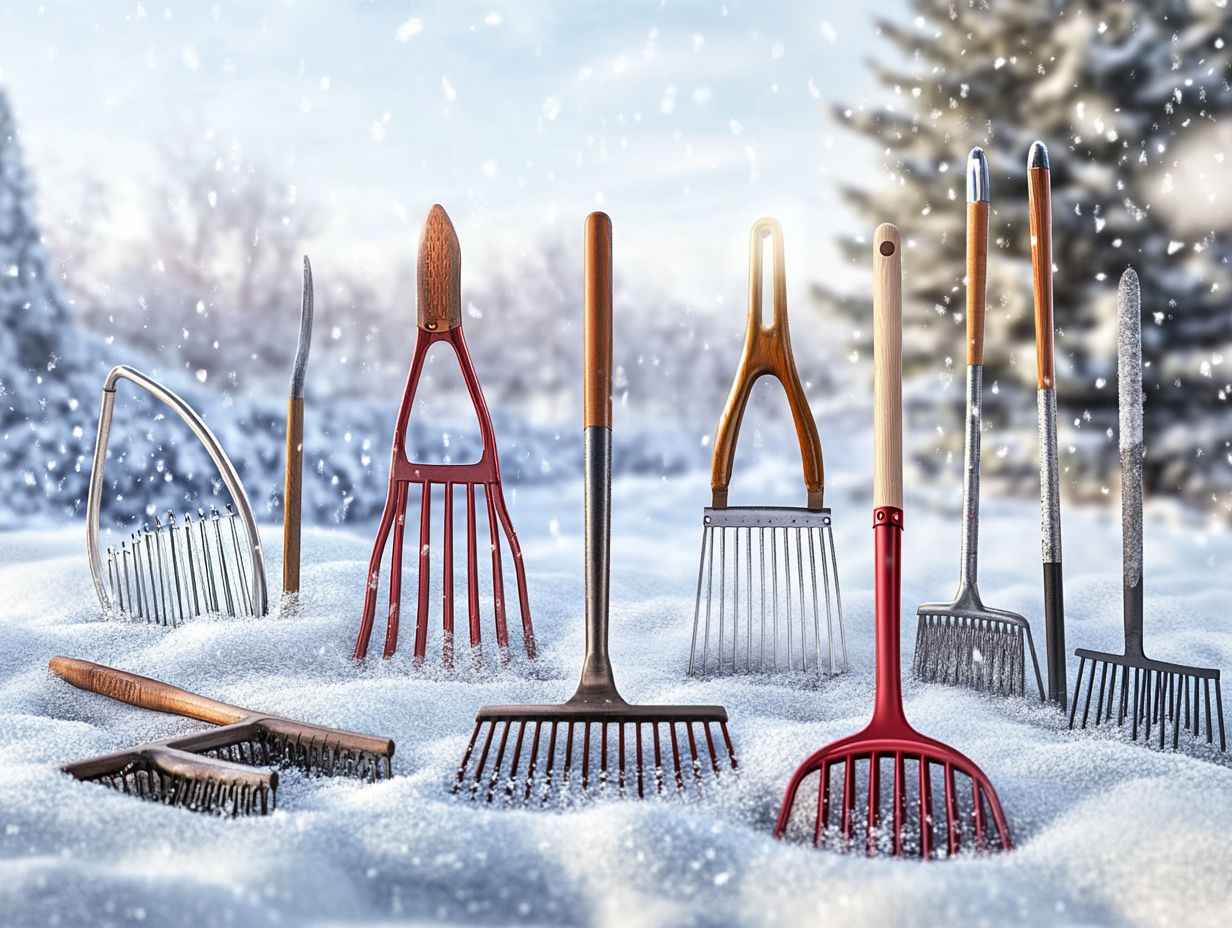
The best rake for winter cleanup is a sturdy metal rake with strong tines. A lake rake works well for larger areas, handling heavy debris and wet leaves without breaking.
Can I use a regular garden rake for winter cleanup?
A regular garden rake can work for light tasks. However, it s not suitable for heavy jobs as the tines may bend or break with wet leaves.
What is the ideal width for a winter cleanup rake?
The ideal rake width for winter cleanup is 22-24 inches. This size allows for efficient cleanup without being too heavy.
Should I choose a metal or plastic rake for winter cleanup?
Metal rakes are preferred for winter cleanup due to their durability. If you have delicate plants, consider a plastic rake to avoid damage.
What type of handle should I look for in a winter cleanup rake?
A long, wooden handle is best for winter cleanup rakes. It provides better leverage to clear debris from tight spaces.
Is it necessary to have a specialized winter cleanup rake, such as a roof rake?
While not necessary, specialized rakes like berry or tarmac rakes can make cleanup easier. They often have sturdier tines and wider heads for handling heavy debris.
For expert maintenance advice, check out Lawnstarter or Atlas Obscura for helpful mulching tips!

